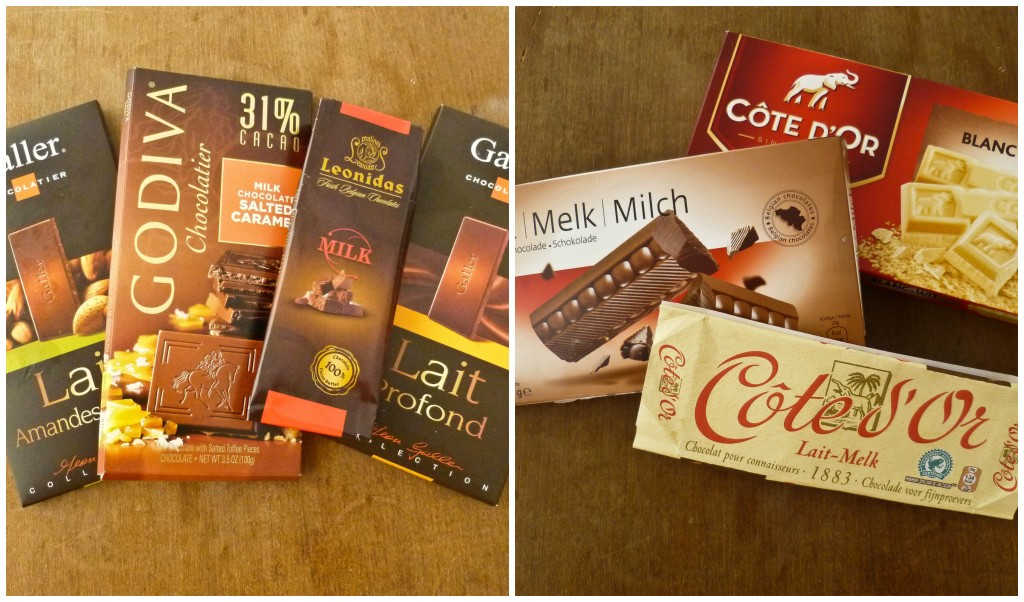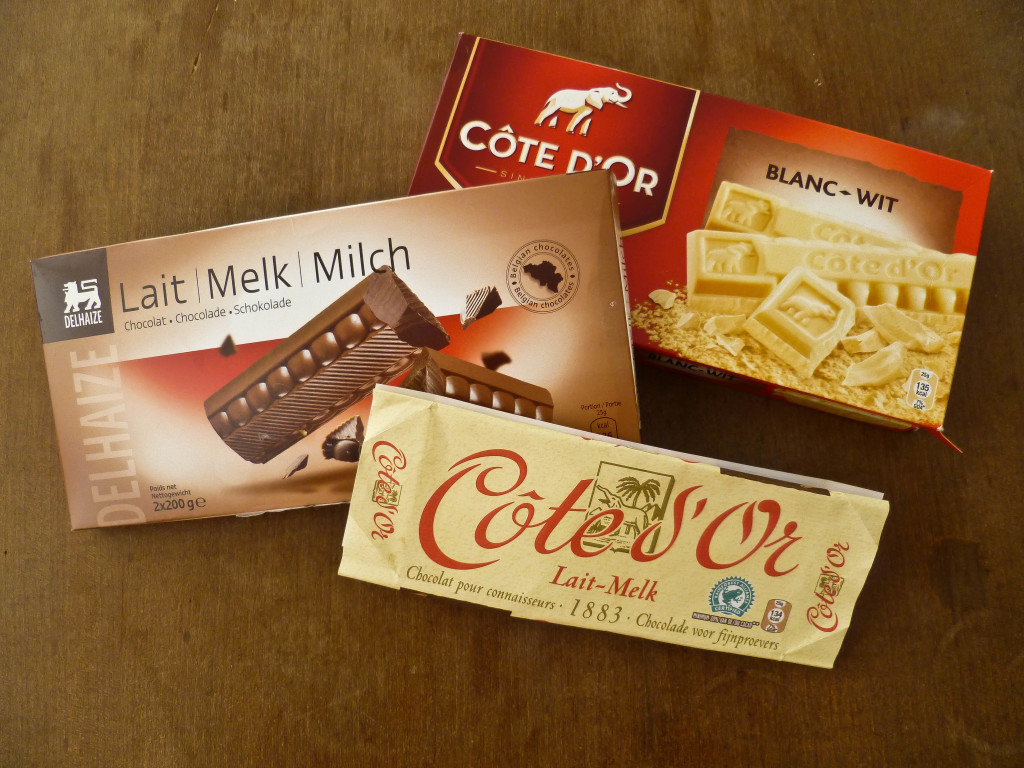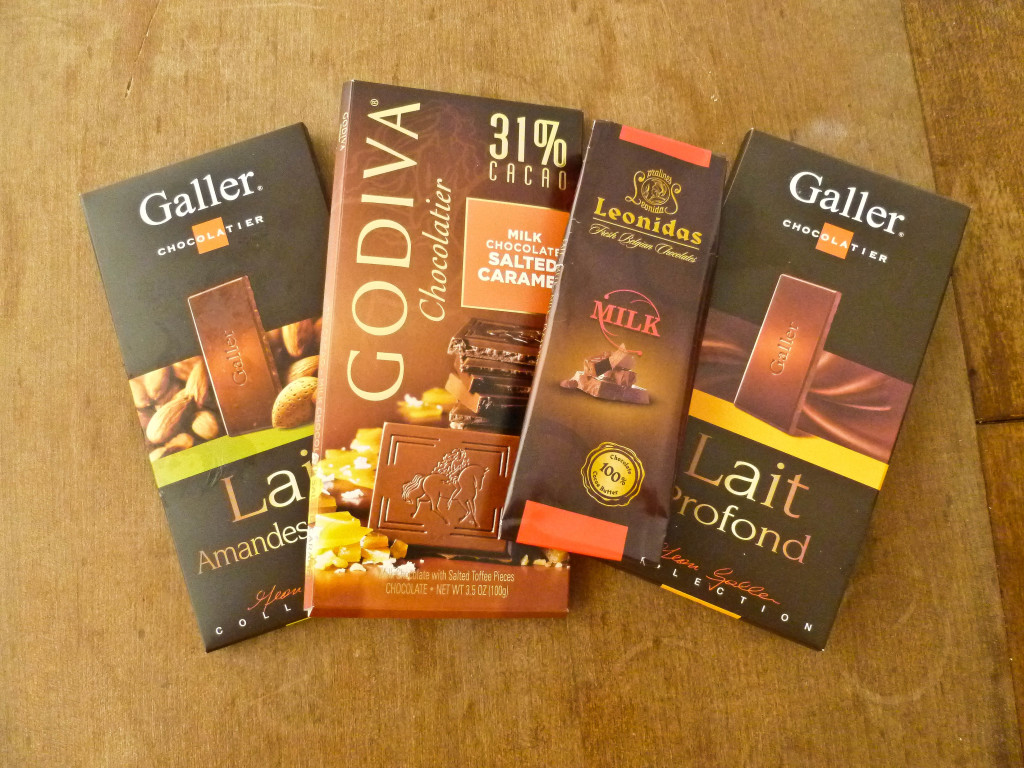When most people think of Belgium, they think of Belgian chocolate. We, of course, were no different.
I have a bigger chocolate obsession than Scott does, meaning that even though I loved devouring huge portions of Belgian frites, I was determined to try several different brands of locally-produced chocolate.
One of the things we discovered from the super-cool Use-It map we were given by our apartment owner when we arrived was that locals in Brussels hardly ever bother buying the expensive chocolate produced in the boutique stores around the city unless it is a special occasion. Instead, they prefer to buy the cheaper blocks of chocolate sold in supermarkets.
I can relate to this; instead of purchasing Hotel Chocolat chocolates every week in the UK, I would simply go to my local store and buy a big block of Cadbury’s Dairy Milk. It satisfied my craving and cost half the price.
But I wanted to see whether the chocolate in Brussels sold in supermarkets really was as good as the stuff they were selling in the “big brand” chains, such as Neuhaus and Godiva.
I set myself really tough challenges sometimes 😉
First up: the supermarket brands of Cote D’Or, Cote D’Or Special and the supermarket’s own brand milk chocolate
My first impressions when buying chocolate at the supermarket was how big the blocks are. Often, especially with the supermarket own brand, chocolate will be sold in double packs of 200g. Despite the large amount, it would be competitively priced, meaning that I could use one block for baking and we could eat the other one ourselves.
I couldn’t believe how smooth and creamy supermarket chocolate could be! For the price, the supermarket milk chocolate was really tasty and melted when for baking.
This also applied to the Cote D’Or white chocolate, which again came in a double pack, but this had a slightly more “artificial” taste (as white chocolate sometimes can). Again, great for the price and comparable to more expensive brands at home.
The Cote D’Or special brand was a single block, packaged in different paper. We opted for the milk chocolate (our favourite, if you couldn’t tell) but found the chocolate slightly disappointing considering the higher price and higher quality packaging. Although the chunks were a bigger size, which I like, the chocolate wasn’t terribly smooth or creamy and left a slightly odd aftertaste.
Next up: the “Big Boys” of Godiva, Leonidas, Neuhaus and Galler
I have eaten Godiva chocolate once before and that was on my 18th birthday. My sister had lived in Brussels for a few months and had purchased me a gift basket with an assortment of their chocolates in it. I remember them being delicious, but I remember little more than that. We visited their store in Grand Sablon and weren’t really tempted by their individual chocolates, so we opted for a pre-packaged block of their milk chocolate with salted caramel. The name was a bit misleading, as the chocolate actually contained small pieces of toffee, not salted caramel – I was expected a creamy soft centre, but instead it was a thin bar containing pieces of hard toffee. The chocolate itself was deliciously creamy and melted wonderfully in the mouth. 4.50 Euros also wasn’t a bad price to pay.
The Leonidas stores always seemed busy and too full of products that weren’t their chocolates. Not sure if that’s the way they market they business or just another way to make money, but when I go in a chocolate shop, I want to be distracted by chocolates, not biscuits and sweets from other companies. I purchased a small pre-packaged bar of Leonidas milk chocolate, in order to compare it to the other milk chocolates I had tried. The chocolate was decent enough, but almost slightly more bitter than the Godiva. It was thin and melted nicely, but just wasn’t quite as creamy as I’d hoped.
The bar of Neuhaus I purchased is not shown in the photo because it was accidentally thrown away in our apartment, but both Scott and I bought a small bar of flavoured chocolate each. I opted for the Speculoos (a Dutch spiced biscuit, often referred to as a “windmill biscuit”) and Scott went for the milk chocolate with praline centre. The milk chocolate was creamy and rich and my soft centre had a wonderful crunch from the gingery biscuit. Scott’s was equally as tasty, being smooth and silky throughout.
Galler is a bit different. We actually purchased the bars of Galler in the supermarket, however I didn’t include it in that list because it does have its own stores (or I saw at least one in the Grand Place). I tried two different Galler bars: one plain milk chocolate and one milk chocolate with almonds. I have to say that the milk chocolate was delicious. The bars were thin and the chocolate was fine and smooth and creamy.
The verdict? You definitely can’t go wrong with the supermarket brands for quality and price, and I would even suggest spending a little extra at the store and buying the Galler. All chocolate sold in Belgium is made in Belgium and is of a higher quality than most countries, so you shouldn’t feel as though you haven’t tasted “good” chocolate. If you really want to splurge, the chocolate at Godiva was probably my favourite, while the small flavoured bars at Neuhaus offered something a bit different.




Chocolate from the supermarket do not contain lots of cocoa and cocoa butter. Main infredients are sugar and soy lecithin unfortunately. I think organic Ombar and Valrhona (used by pastry chefs) are one of the best sold in some supermarkets.